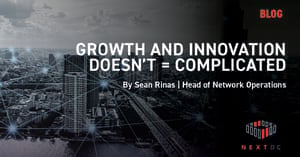By Steve Martin, Head of Channel
Centorrino Technologies (CT) is one of NEXTDC’s specialist partners. The dynamic nature of their business reverberates through their partnering strategies, and the way they leverage the depth of our ecosystem to meet the evolving Hybrid- and Multi-Cloud architecture requirements of government, education, and corporate organisations.
As digital transformation accelerates in a world changed forever by COVID-19, the 2020 IDG Cloud Computing Survey tells us that 93% of all organisations are now at least “somewhat” in the cloud. Flexera research from 2020 found that organisations use an average of 2.2 public clouds and a further 2.2 private clouds.
They’re last year’s numbers. That’s an eon ago when you look at the current rate of technical evolution. It is, however, still very symbolic of what our partners are seeing at the coalface as they build resilient, interconnected architectures that allow hungry customers to transact, disrupt and compete in the global digital economy.
A broad range of industry analysts concur that the ongoing global health crisis that first reared in 2020 has sent cloud adoption on a revised, warp-speed trajectory. Some say that digital transformation has been accelerated by as much as 10 years. Certainly, you can see that in our everyday lives as entertainment, hospitality, education and retail has changed forever.

Leveraging cloud ecosystems
Adam Centorrino, founder and managing director of CT, is creating great value for his customers by applying the resilience, security and performance that comes with interconnecting multiple cloud platforms from within a connected ecosystem such as the one we foster at NEXTDC. CT also manages private cloud environments for customers with its own physical infrastructure in NEXTDC facilities.
Wherever possible he is tuning his customers into the cost efficiency, productivity and flexibility benefits that are achievable by adopting a multi-cloud philosophy as a core component of their IT strategy.
“In my business meetings, I am seeing an increased tendency for I.T leaders to embrace a Multi-Cloud approach and for good reason,” Centorrino said. Here are a few of his thoughts on what is driving reasons why.
ROI
Every dollar counts as businesses try to get more from less when it comes to stretching the I.T budget. With nearly all organisations accessing cloud services, it is important to find the right cloud at the right cost for individual workloads.
“Not every cloud environment suits every app or business need,” Centorrino said. “The best fit is determined by individual metrics, individual applications, and for individual business priorities. Cost analysis tools allow for Multi-Cloud environments to be configured based on optimising ROI.”
Best fit cloud Despite working on roughly the same principle of providing aaS infrastructure, each of the public cloud platforms have their own unique capabilities. Some are better suited to certain tasks than others, it takes an experienced partner to help organisations work out which cloud to use and for what application. “Maintaining workloads in multiple clouds allows you to leverage the best features of each cloud offering,” Centorrino said.
Don’t risk it
Relying on just one cloud provider is a risky strategy. Just like any good redundancy, back-up and disaster recovery plan, diversity in both geography and suppliers means that if something goes wrong you have a fall-back position. “Diversifying your cloud investment prevents lock-ins and mitigates the risks associated with a single cloud setup,” according to Centorrino.
Autonomous infrastructure
Nobody wants to be locked into a single vendor’s product roadmap. After “unprecedented”, “flexibility and agility” became the new catchcries of a post COVID world. To make sure you have options in a rapidly evolving world and are able to move quickly when priorities or external circumstances change, you need to have competence in multiple technology stacks.
The world’s leading cloud platforms literally invest billions of dollars in R&D every year. They are always innovating and attempting to disrupt each other. You want to be ready to deploy if one of their technical advances in the future resonates with you.
“Multi-Cloud environments empower organisations to mix and match platforms and vendors so their workloads are not locked-in to individual cloud providers,” Centorrino said.
Strategy, planning and mitigation
Centorrino added that it takes experience to know when and how to best adapt to Hybrid- and Multi-Cloud architecture as technology becomes ever more central to organisational success.
“Technology is ever more intrinsic to how our customers operate,” he said. “Our challenge is to ensure that our services get delivered in alignment with their organisational objectives. We tailor our services to meet their risk and compliance requirements.
"Resilience is such a big factor for technology solutions today. Cloud platforms live and die by adhering to the highest possible uptime SLAs. NEXTDC gives us a solid platform upon which we can build our solutions and deliver on our uptime promises because we know how well the facilities are designed, built and operated."
"The NEXTDC ecosystem is diverse and agnostic, and we connect to a large number of platforms and service providers that we use in developing bespoke customer solutions.”
Reach out to NEXTDC to better understand how we can help you optimise your Multi-Cloud architecture.


